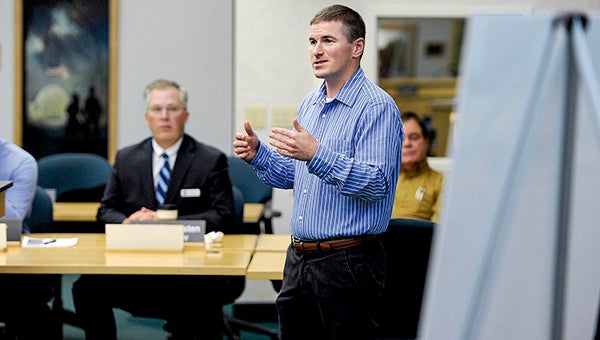Legislative support needed for water quality project plan
Published 8:57 am Thursday, May 26, 2016

Justin Hanson, Soil and Water Conservation District manager, begins his presentation for members of the Minnesota House Bonding Committee in the City Council chambers earlier this year. — Herald file photo
By Justin Hanson
Justin Hanson is the district manager of the Mower Soil & Water Conservation District and the administrator of the Cedar River Watershed District
On the banks of the Cedar River-Dobbins Creek confluence last summer, local leaders gathered to celebrate a giant step toward improving our local water quality.
Cedar River Watershed District joined The Hormel Foundation and Austin Vision 2020 to announce the Foundation’s $3.2 million grant to support the CRWD’s five-year Capital Improvement Plan for water quality.
That significant gift laid a strong foundation from which CRWD could seek matching funds for an overall $8.4 million plan to build 25 projects by 2020 along or near the Cedar River and Dobbins Creek. When all installed, these projects should reduce stormwater flows by 8 percent in the Cedar River by capturing stormwater and slowly filtering it out.
To do our job, however, we are counting on the Minnesota Legislature to get its work done and pass a state bonding bill.
CRWD is among many in the state left disappointed by how this year’s legislative session ended, especially given that a bonding bill with money for water quality and flood prevention appeared ready for approval by the House and Senate as time ran out. Our request was part of a statewide flood-reduction package in the bill as our CIP initiative also will reduce flooding while improving water quality.
We went into this session with a strong need for funding to match a generous donation from The Hormel Foundation. The agricultural economy is not doing well so the CRWD board and staff are sensitive about passing on matching obligations through local levy funds. It’s likely that project levies will be needed to address part of our needed match. But we think it’s critical that we find outside sources to ease those local obligations. We hoped to find that in this legislative session.
We are anxious for Gov. Mark Dayton to call a special session as soon as possible to make legislators reconvene and finish their business. Without bonding funds this year, our CIP initiative will experience project delays and we will need to explore other options to fill the funding gap left by the Legislature.
In the latest version of the bonding bill, CRWD was poised to receive about $800,000 for high-priority projects, which are prone to flash flooding. While this is critical funding, it was well short of our needs. Our project allotment was shrinking throughout the session. Then on the last night, it disappeared.
We had hoped to secure $1.6 million in bonding this year to start and complete nearly $4 million in projects by 2018. Another $4.5 million in projects would be part of Phase II in 2019-2020, with another bonding request in 2018.
The Hormel Foundation’s $3.2 million grant covers about 40 percent of the needed funding for CRWD’s CIP initiative, with about $4.2 million planned from the State of Minnesota through bonding and Clean Water funds of which we already have secured $600,000 for two projects in the development phase.
An additional $1 million also is committed by the CRWD Board of Managers for CIP projects.
CRWD’s long-term goal is to reduce peak flood flows by 20 percent in our watershed. We will continue to work aggressively in this mission but we need the state to be a partner in this effort.
We will continue to chase after state grants; however, these funds are highly competitive and difficult to count on. Bonding is a great fit as it is a long-term, capital investment in clean water and flood retention, which will live on for generations. CIP is an exciting challenge that has drawn a great deal of interest across the state. Our colleagues are interested in how a community our size can have so much local interest in a project like this.
We all are fortunate to live in a community invested in the improvement and protection of our waterways. It’s definitely unique within our state.
Mower SWCD provides technical assistance to landowners with conservation practices that protect land and water resources. SWCD also administers the Cedar River Watershed District to improve water quality and reduce flooding. This column runs monthly on the last Thursday. For more, visit the Mower SWCD and CRWD websites and Facebook pages. Comments can be sent to tim.ruzek@mowerswcd.org.



